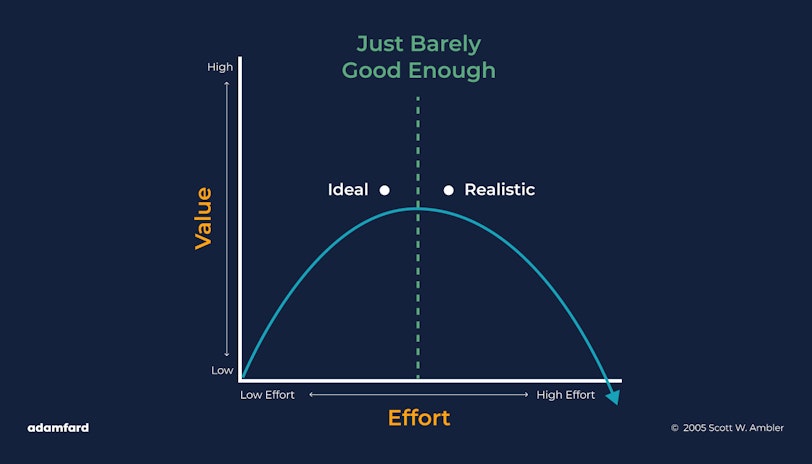About 20 years ago, Agile was merely a set of management practices aimed at developers. In 2020, however, it’s much more than just that. Agile has permeated a multitude of different types of organizations, teams, and crafts.
An important field that has been influenced by this methodology is design. Today, companies all around the world use it as a framework for establishing how their products should look and feel. It’s called Agile design.
In this article, we’ll take a look at how your team can incorporate Agile principles in design and user experience work.
Here goes!
So what is Agile?

Agile is a people-oriented management system, designed to make teams much more adaptable to changes. It appeared as a response to the then-popular Waterfall methodology, which has its fair share of shortcomings. It’s considered to be clunky and unforgiving, among other things.

Agile intended to change the focus from rigid processes and orient it towards “authentic human interactions.”
The methodology revolves around four essential values:
Individuals and interactions > processes and tools;
Good software > detailed documentation;
Collaborating with customers > negotiating contracts;
Adapting to change > following rigid plans;
Why is Agile so popular?
Probably the most critical aspect of this methodology is that it’s iterative and evolutionary. It allows teams to improve the product with each iteration.
More importantly, teams can decide what improvements need to be made on each short iteration. As a result, the development process is both quick and rational — it addresses the most pressing issues immediately.
Plus, regular communication is a crucial aspect of the process too. Agile enables stakeholders and clients to provide teams with regular feedback. This is what sets this methodology apart from other approaches.
According to a study published by PwC, projects executed within an Agile methodology are nearly 30% more successful.
Agile Design Process, i.e. How To Apply Agile to Design
For a very long time, design has not been perceived as an iterative process. Often, designers would be pushed to start working on high-fidelity prototypes straight away. This often resulted in poorly thought out products that didn’t really address users’ needs adequately.
The Agile design process, on the other hand, is an iterative approach. Here’s a basic layout of the process:
Understand, Research, Sketch, Design, Prototype, Test, Refine
This approach allows designers to go beyond “just creating a product.” Instead, they’re able to improve a product’s design with each iteration and solve important problems. This will, as a result, lead to better user experience and customer satisfaction.

Also, Agile is comfortable with uncertainty. It’s important that teams embrace the so-called “unknown.” They need to accept that there are many questions that they don’t have answers to at this point. These answers will emerge as the design process continues in short iterations. This way, teams can continuously make small but very rational decisions.
Read more about Lean UX.
Interestingly, a principle that makes Agile product design efficient is called “Just Barely Good Enough.” The designs that teams deliver at the end of an iteration need to be somewhere between ideal and realistic. This reflects the very nature of this methodology.

You’re not trying to deliver a perfect product straight away. In Agile, steady and meaningful progress is more important than perfection.
Agile is iterative. Design is iterative. Why couldn't they work together?
— Jeff Gothelf
Agile design methodology: benefits and conditions
Naturally, Agile design has a broad spectrum of benefits. However, there are also some important conditions that need to be met to make things work.
Benefits:
Clients are more involved and provide teams with valuable feedback at all steps of the process;
An iterative process both allows to identify problems and respond to them very quickly;
Receiving regular feedback helps teams stay motivated and feel productive. Both are essential for boosting team morale;
An iterative process allows for a more transparent environment;
Agile enables teams to solve critical and imminent issues instantly, which saves a lot of money and time. The further a bug or a design issue makes it in the development process — the more expensive it is to solve it.
Conditions:
Abstain from rushing things. We often tend to be perfectionists, but Agile isn’t about reaching perfection instantly.
Because Agile operates in sprints, managers must abstain from micromanaging team members. It’s essential to learn to trust your colleagues and their expertise. This methodology is all about self-organizing.
Despite the fact that micromanagement is detrimental to Agile, it still demands a leader position. This person is responsible for keeping the team on track;
It’s essential to establish when the job is done. One of the pitfalls of Agile is that it can continue reiterating the product endlessly. However, there is a moment when it becomes counterproductive.
Be prepared to take criticism — a lot of it. Adopting an Agile approach towards design implies involving your clients in all the phases of the design process. This way, they get a better understanding of what their product will look like, and you lower your chances of unpleasant surprises.
“Always be testing.” An essential part of designing in an Agile spirit is testing things as frequently as possible. Designers need to break large problems into smaller ones and test possible solutions.
The takeaway
Agile has proven to be an excellent approach to software development. There are few reasons why design teams shouldn’t adopt this methodology to make their work more productive and efficient.
More importantly, this approach to development enables both intra- and inter-team communication. By communicating efficiently, all the essential teams can reach solutions that increase the value of the product.

The Art of Launching a Product
Get Our Free E-book on Launching Products with the Agile Approach
Download Now



